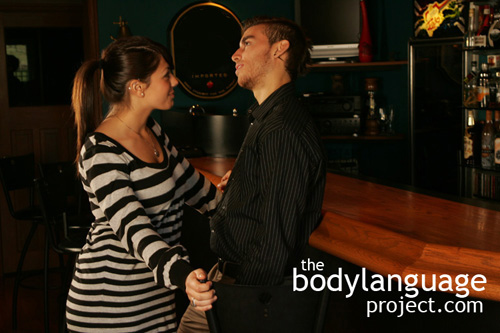Body Language of Counting On Fingers
Synonym(s): N/A
Description: It is done by rhythmically bringing the index finger over the opposite hand as if to anchor each point being delivered.
In One Sentence: Counting rhythmically on the fingers denotes a person who is condescending or trying to be clear about various points.
How To Use it: Use the gesture in order to appear superior to another person or that you are frustrated with having to repeat orders, steps, or points you have already made. By belittling others, you may achieve superiority if they do not supersede or dismiss your arrogance. In other words, avoid counting on the fingers, at least in a way that is not genuinely helpful.
Context: General.
Verbal Translation: “I’m going to really slow things down for you and make my points deliberate by counting out each point by number.”
Variant: The Baton Gesture is similar in that each point is emphasized rhythmically, but this is more of an artifact of passion. See Baton Gestures.
Cue In Action: After going over the issues five times, his wife decided he just wasn’t going to get it. She started over with her fingers “ONE, I’m not going to pick up Jimmy, TWO, I expect you to fix the garage door, THREE…”
Meaning and/or Motivation: A cocky, arrogant and sometimes confident gesture implying that a person needs to keep up with the various points that are being made. The sender does not feel the receiver is intelligent enough to keep up. Think of counting out loud in order to give a child a fair warning to obey you.
Cue Cluster: Counting on fingers is often coupled with leaning in, a condescending voice, arms akimbo, invasion of space, palm down displays, erratic gesticulation and angry, sneering, or disgusted facial expression.
Body Language Category: Arrogance or arrogant body language, Aggressive body language, Anger, Authoritative body language, Dominant body language, Frustration or frustrated body language, Hostile body language, Negative body language.
Resources:
Austin, Elizabeth E. and Naomi Sweller. Presentation and Production: The Role of Gesture in Spatial Communication. Journal of Experimental Child Psychology. 2014. 122: 92-103.
http://bodylanguageproject.com/articles/gestures-help-children-but-not-adults-in-recall-study/
Alibali, M.W., Heath, D.C., and Myers,H.J. (2001). Effects of visibility between speaker and listener on gesture production: Some gestures are meant to be seen. Journal of Memory and Language, 44, 169–188.
Beattie, G., & Shovelton,H.(1999).Mapping the range of information contained in the iconich and gestures that accompany spontaneous speech. Journal of Language and social Psychology, 18, 438–462.
Bailenson, J. N. & Yee, N. 2005. Digital Chameleons: Automatic assimilation of nonverbal gestures in immersive virtual environments. Psychological Science, 16: 814-819.
Cook, Susan Wagner; Terina KuangYi Yip and Susan Goldin-Meadow. Gesturing Makes Memories That Last. Journal of Memory and Language. 2010. 63: 465-475.
http://bodylanguageproject.com/articles/gesturing-really-work-improve-memory
Ekman, Paul ; Friesen, Wallace V. ; O’sullivan, Maureen ; Chan, Anthony ; Diacoyanni-tarlatzis, Irene ; Heider, Karl ; Krause, Rainer ; Lecompte, William Ayhan ; Pitcairn, Tom ; Ricci-bitti, Pio E. ; Scherer, Klaus ; Tomita, Masatoshi ; Tzavaras, Athanase. Universals and Cultural Differences in the Judgments of Facial Expressions of Emotion
Journal of Personality and Social Psychology. 1987. 53(4): 712-717.
Fischer, Julia; Peter Fischer; Birte Englich; Nilüfer Aydin and Dieter Frey. Empower My Decisions: The Effects of Power Gestures on Confirmatory Information Processing. Journal of Experimental Social Psychology. 2011. 47: 1146-1154.
http://bodylanguageproject.com/articles/downside-power-posing-body-language-looking-power-posing-action-study/
Goldin-Meadow, Susan; Susan Wagner Cook, and Zachary A. Mitchell. Gesturing Gives Children New Ideas About Math. Association for Psychological Science. 2009. 20 (3): 267-272.
http://bodylanguageproject.com/articles/gesturing-helps-children-learn-math/
Gorkan Ahmetoglu, Viren Swami. Do Women Prefer “Nice Guys?” The Effect Of Male Dominance Behavior On Women’s Ratings. Social Behavior And Personality, 2012; 40(4), 667-672.
http://bodylanguageproject.com/articles/how-to-significantly-increase-male-attractiveness-with-simple-body-language-nice-guys-finish-last-once-again/
Goldin-Meadow, S. Widening The Lens: What The Manual Modality Reveals About Language, Learning and Cognition. Philosophical Transactions of the Royal Society B: Biological Sciences. 2014; 369-1651. 20130295 DOI: 10.1098/rstb.2013.0295
http://bodylanguageproject.com/articles/spontaneous-hand-gestures-help-children-learn-study/
Holle, H., & Gunter,T.C. (2007). The role of iconic gestures in speech disambiguation: ERP evidence. Journal of Cognitive Neuroscience, 19, 1175–1192.
Holler, J., Shovelton, H.,& Beattie, G.(2009).Do iconic hand gestures really contribute to the communication of semantic information in a face-to-face context? Journal of Nonverbal Behavior, 33, 73–88.
Hubbard, A.L., Wilson, S. M., Callan, D. E., & Dapretto, M.(2009).Giving speech a hand: Gesture modulates activity in auditory cortex during speech perception. Human Brain Mapping, 30, 1028–1037.
Kelly, S. D., Barr, D. J., Church, R. B., & Lynch, K.(1999).Offering a hand topragmatic understanding: The role of speech and gesture in comprehension and memory. Journal of Memory and Language, 40, 577–592.
Kelly, S. D., Creigh, P., & Bartolotti, J.(2009).Integrating speech and iconic gestures in a Stroop-like task: Evidence for automatic processing. Journal of Cognitive Neuroscience, 22, 683–694.
Kelly, S.D., Kravitz, C.,& Hopkins, M.(2004).Neural correlates of bimodal speech and gesture comprehension. Brain and Language, 89(1), 253–260.
Krahmer,E., & Swerts, M.(2007).The effects of visual beats on prosodic prominence: Acoustic analyses, auditory perception and visual perception. Journal of Memory and Language, 57, 396–414.
Krauss, R. M., Dushay, R.A., Chen,Y., & Rauscher, F.(1995).The communicative value of conversational hand gesture. Journal of Experimental Social Psychology, 31(6), 533–552.
Kendon, A. 1994. Do gestures communicate? A review. Research on Language and Social Intraction. 27(3): 175-200.
Lindemann, Oliver ; Alipour, Ahmad ; Fischer, Martin H. Finger counting habits in Middle Eastern and Western individuals: An online survey. Journal of Cross-Cultural Psychology. 2011 42(4): 566(13).
Lindemann, Oliver ; Alipour, Ahmad ; Fischer, Martin H. Finger counting habits in Middle Eastern and Western individuals: An online survey. Journal of Cross-Cultural Psychology. 2011 42(4): 566(13).
Leonard, T., & Cummins, F.(2010).The temporal relation between beat gestures and speech. Language and Cognitive Processes, 26, 1457–1471.
Parrill, F. and I. Kimbara. 2006. Seeing and hearing double: the influence of mimicry in speech and gesture on observers. Journal of Nonverbal Behavior 30(4): 157-166.
Renninger, Lee Ann; T. Joel Wade, Karl Grammer. Getting that female glance: Patterns and consequences of male nonverbal behavior in courtship contexts. Evolution and Human Behavior. 2004; 25: 416–431.
http://bodylanguageproject.com/articles/part-i-how-to-read-male-sexual-body-language-a-study-for-women-and-the-men-who-wish-to-cheat-the-system/
Singer, Melissa A. and Susan Goldin-Meadow. Children Learn When Their Teacher’s Gestures and Speech Differ. American Psychological Society. 2005. 16(2): 85-89.
http://bodylanguageproject.com/articles/children-learn-better-when-teachers-use-gesture/
Simone, Pika; Nicoladis, Elena; Marentette, Paula, F. A cross-cultural study on the use of gestures: Evidence for cross-linguistic transfer? Bilingualism Language and Cognition. 9(3): 319 -327
Sun Jung, Hyo Sun and Hye Hyun Yoon. The Effects of Nonverbal Communication of Employees in the Family Restaurant Upon Customers’ Emotional Responses and Customer Satisfaction. International Journal of Hospitality Management. 2011. 30: 542-550.
http://bodylanguageproject.com/articles/effect-body-languagel-cues-family-restaurant/
Teixeira Fiquer, Juliana; Paulo Sérgio Boggio and Clarice Gorenstein. Talking Bodies: Nonverbal Behavior in the Assessment of Depression Severity. Journal of Affective Disorders. 2013. 150: 1114-1119.
http://bodylanguageproject.com/articles/using-nonverbal-behaviour-to-assess-depression-severity/
Wu, Y. C., & Coulson, S.(2005).Meaningful gestures: Electrophysiological indices of iconic gesture comprehension. Psychophysiology, 42, 654–667.
Wang, Lin ; Chu, Mingyuan Neuropsychologia. The role of beat gesture and pitch accent in semantic processing: An ERP study. 2013, Vol.51(13), pp.2847-2855.



